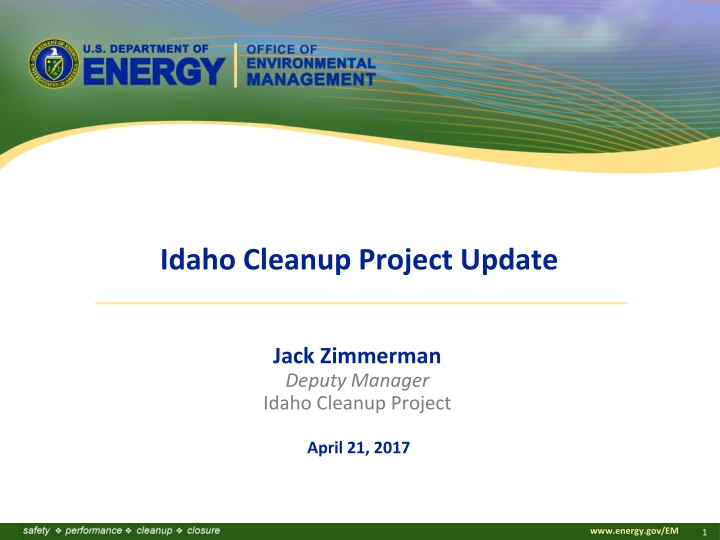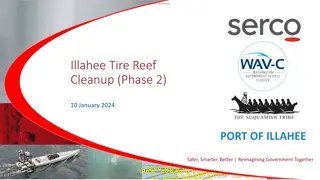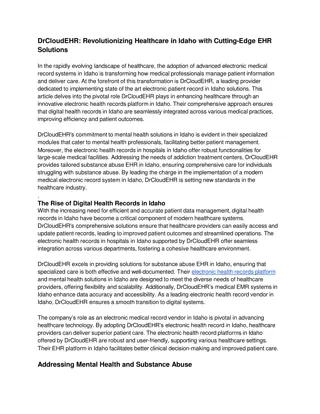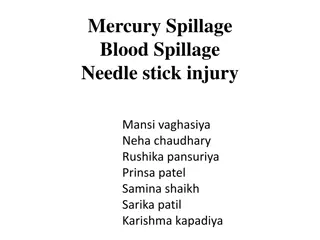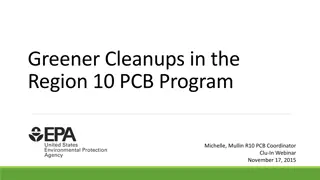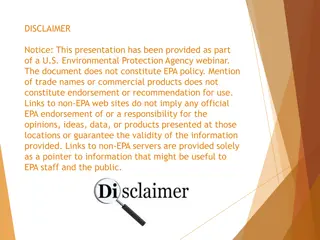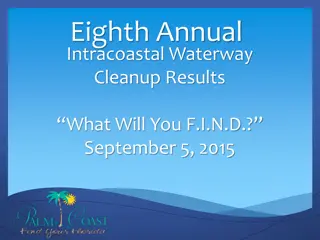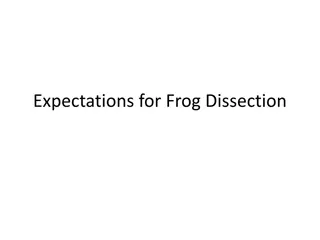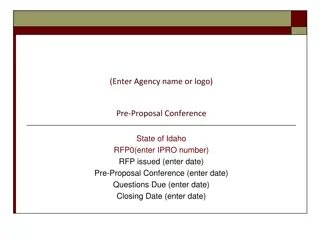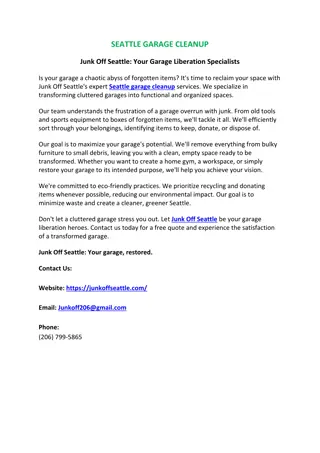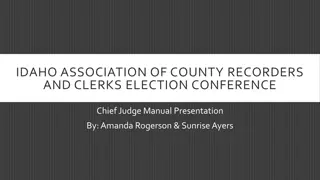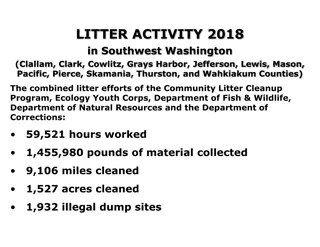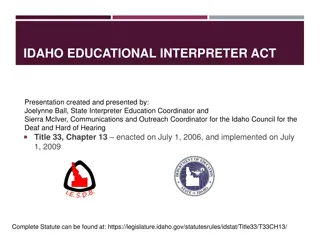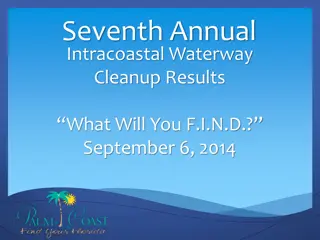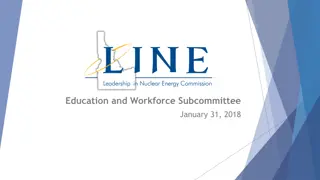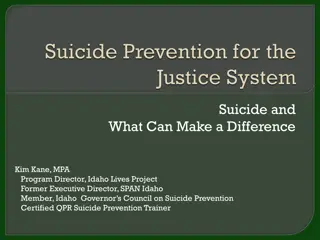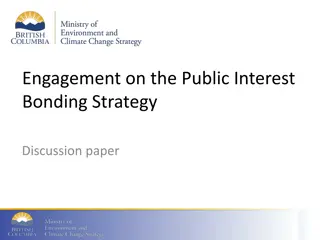Idaho Cleanup Project Update
Stored Transuranic Waste Background: DOE's Idaho Site received and stored about 65,000 cubic meters of transuranic waste from other sites. Completion of Stored Waste Retrieval: The last of the stored waste was retrieved in February, with the Governor and state officials attending a celebration. Resuming WIPP Shipments after a three-year hiatus, with anticipation of 60 more shipments to WIPP. Settlement Agreement TRU Production Status. Buried Transuranic Waste Background: Cleanup agreements mandate the removal of targeted transuranic waste from the burial ground. Idaho is actively involved in managing and disposing of transuranic waste.
Download Presentation

Please find below an Image/Link to download the presentation.
The content on the website is provided AS IS for your information and personal use only. It may not be sold, licensed, or shared on other websites without obtaining consent from the author.If you encounter any issues during the download, it is possible that the publisher has removed the file from their server.
You are allowed to download the files provided on this website for personal or commercial use, subject to the condition that they are used lawfully. All files are the property of their respective owners.
The content on the website is provided AS IS for your information and personal use only. It may not be sold, licensed, or shared on other websites without obtaining consent from the author.
E N D
Presentation Transcript
Idaho Cleanup Project Update Jack Zimmerman Deputy Manager Idaho Cleanup Project April 21, 2017 www.energy.gov/EM 1
Stored Transuranic Waste Background: From 1970 to 1984, DOE s Idaho Site received and stored about 65,000 cubic meters of transuranic waste from other sites. Waste was stacked on an asphalt pad, then covered with an earthen berm. In the 1990s, a large retrieval building was constructed over the berm. In 2003 DOE s contractor began the task of retrieving the waste so it could be characterized, repackaged, certified and shipped off-site for disposal. www.energy.gov/EM 2
Completion of Stored Waste Retrieval The last of the 65,000 cubic meters of stored transuranic waste was retrieved in February of this year. Idaho Gov. Otter and other state officials attended celebration on March 2, 2017. The last box remaining to be retrieved (above); Gov. Otter at ceremony marking completion (left). www.energy.gov/EM 3
Shipping Transuranic Waste Background: DOE s Idaho Site is the largest shipper of transuranic (TRU) waste to the Waste Isolation Pilot Plant (WIPP) in New Mexico for disposal. The Idaho Site has shipped more than 51,000 cubic meters of waste to WIPP and other licensed facilities for off-site disposal. In 2014, an underground fire and a radiation release at WIPP caused the repository to temporarily close. Consequently, shipments from Idaho to WIPP ceased in February, 2014. Idaho State trooper Tony Anderson talks to attendees at the kick-off of the WIPP Road Show for the western corridor shipping route at Fort Hall on March 27, 2017. www.energy.gov/EM 4
Resuming WIPP Shipments After a three-year hiatus, Idaho resumed shipping to WIPP on April 6, 2017. DOE resumed shipping transuranic waste from the Idaho Site to WIPP on April 6, 2017. We are anticipating 60 more shipments to WIPP between now and next January. We are in the process of verifying that all previously certified containers meet the new criteria for safe disposal at WIPP. We also have about 10,300 cubic meters of waste that remain to be treated and shipped for disposal. www.energy.gov/EM 5
Settlement Agreement TRU Production Status www.energy.gov/EM 6
Buried Transuranic Waste Background: From 1954 to 1970, the Atomic Energy Commission s contractors disposed of both transuranic and mixed low-level radioactive waste in unlined pits and trenches at the Idaho Site. Under cleanup agreements reached with the State of Idaho and the Environmental Protection Agency, DOE and its contractors must remove targeted transuranic waste from at least 5.7 acres of the burial ground, and must retrieve and ship at least 7,485 cubic meters of targeted waste out of Idaho by the end of 2023. The agreements also require a cap over the burial ground, and continued monitoring and evaluation of the burial site and the aquifer. www.energy.gov/EM 7
Buried Waste Exhumation Retrieval of targeted buried waste remains ahead of schedule. Construction of the last retrieval enclosure should be finished this spring. Design work has begun on the cap for the burial ground. www.energy.gov/EM 8
Liquid Waste Treatment Background: There are about 900,000 gallons of liquid radioactive waste stored in three stainless steel underground tanks at the Idaho Nuclear Technology and Engineering Center. Our regulatory agreements required this waste be solidified and the liquid waste tanks closed by December 31, 2012. The Integrated Waste Treatment Unit was constructed to treat the waste, but design and mechanical problems have prevented the beginning of waste treatment. www.energy.gov/EM 9
Fluor Idaho IWTU Phased Approach Phase 1 Phase 2 Phase 3 Phase 4 Completed Phase 1 in late October and are making notable progress during Phase 2. www.energy.gov/EM 10
Phase 1 Results Are Shaping Phase 2 Activities The IWTU challenges can be broken down into two distinct areas: Chemical/fluidization mainly associated with sand castling, the fluidization process, and wall scale in the Denitration Mineralization Reformer (DMR). Mechanical/equipment primarily in relation to the auger-grinder and ring header. www.energy.gov/EM 11
Issues Addressed by Simulant Runs All Issues with DMR Mike Swain/Leo Thompson Runs 1-3 Runs 1-3 Run 2 Runs 1-3 Auger-Grinder: Primary Focus of Simulant Run 1 Run 1 12 12 www.energy.gov/EM
Resolution of Mechanical/Equipment Challenges In past waste simulant runs, the auger-grinder performed poorly or failed. A cementitious material formed inside the auger-grinder causing it to seize. A modified auger-grinder was fabricated with more aggressive blades and a higher horsepower motor. Simulant Run 1 of Phase 2 showed significant performance improvements with respect to torque and flow. Original design of auger-grinder after May, 2016 simulant run (above) Newly designed auger-grinder after March, 2017 simulant run (right). www.energy.gov/EM 13
Use of Hazen to Resolve Chemical/Physical Challenges Testing at Hazen, Colo. facility using a 2-inch-diameter DMR bench-scale unit and an 18-inch diameter DMR pilot plant: Allows testing waste feed rates and determining the optimum rate for simulant conversion to a solid. Allows better understanding of the correlation between feed rate and wall scale formation. Supports larger-scale study of fluidization and temperature variations inside the reaction vessel. 18-in dia DMR vessel design (Above) 18-in diameter DMR vessel (left) and Process Gas Filter (right) 14 www.energy.gov/EM 14
Phase II, Simulant Run 1 The primary objective of Phase II, Simulant Run 1 was to test the new auger-grinder. Newly redesigned auger-grinder operated as designed. More than 18,000 gallons of simulant were converted to a granular solid and were successfully transferred by the auger- grinder. No indication of cementation or seizing. Some of the same chemistry/physical challenges within the DMR were noted during Simulant Run 1, however this was anticipated. Such issues will be addressed through equipment modifications, replacement, and additions during the outage, and tested during Simulant Run 2. Product generated during most recent simulant run. www.energy.gov/EM 15
Upcoming Mechanical/Equipment Changes During this spring/summer, the DMR will be modified to allow access to the interior of the vessel. The ring header, damaged due to fluidizing jet impingement during the December 2015 simulant run, needs to be replaced. A gas heater, associated piping, and controls will be installed to allow the introduction of carbon dioxide and nitrogen gases inside the DMR ring header. Will improve the chemical reactions and fluidization of media and granular waste product. Manway Access Ring Header 16 www.energy.gov/EM 16
Future of Advanced Mixed Waste Treatment Plant New equipment, like this Brokk 4000 robotic arm, could be utilized in a continuing AMWTP future mission to treat waste from off-site. Treatment of Idaho transuranic waste will be completed by Dec. 31, 2018. DOE has identified quantities of transuranic waste at other DOE sites that could be treated at AMWTP prior to shipment to WIPP for disposal. Using AMWTP treatment capabilities could be more economical than constructing comparable treatment capabilities at these sites around the country. DOE continues to review internal studies on potential for using AMWTP to treat off-site wastes after the Idaho mission is complete. www.energy.gov/EM 17
Future of Advanced Mixed Waste Treatment Plant The Idaho Settlement Agreement allows DOE to treat out-of-state waste from other facilities at AMWTP, as long as it is treated within 6 months of receipt, and shipped out of Idaho within 6 months of treatment. Senior DOE management will determine, with appropriate government and other stakeholder input, whether to pursue future mission. AMWTP waste compactor is key element of plant s ability to treat transuranic wastes for off-site disposal. www.energy.gov/EM 18
